Introduction
Doug Hepburn was born in Vancouver, BC on September 16, 1927. During his childhood, he had an operation to help him overcome a congenital foot abnormality. The medical procedure caused the bones in his right ankle to fuse together, and subsequently he lost almost all mobility in this joint. This restriction caused Hepburn's right calf muscles to atrophy and later, when he was a weightlifter, the immobility of his ankle adversely affected his ability to dip underneath a barbell for a snatch or a squat.
At the age of 17, Hepburn took up bodybuilding and weightlifting. At this time, he was just over 5 feet 8 inches tall at 145 pounds bodyweight. Limited by his crippled leg and showing no sign of physical superiority, nobody could have predicted his eventual physical transformation. It is, therefore, a remarkable fact that, through progressive weight training, Hepburn was able to transform himself from an average build into one of the strongest men who ever lived. At the peak of his powers, the mighty Canadian hit the scale between 280 and 300 pounds, and his pressing strength was unsurpassed.
Hepburn was a former Olympic champion, holder of over 50 world records, and a drug-free lifter his entire career! And, think about this—the late strongman didn't even use a belt or any wraps when he set his records. To this day, his drug-free 440-pound press from the shoulders—which was executed in perfect form—remains one of the greatest feats of natural strength the world has ever witnessed. I dare to even say, the greatest!
Sadly, Doug Hepburn passed away on November 22, 2000 at the age of 74. But, his legacy lives on, and all of us can benefit in a very big way by studying how the great strength master trained. So, let's quit messing around and take a serious look at the one arm press and how Hepburn used it to boost his lifting power and build massive shoulders. This is advice straight from the works of the champ, and I am more than proud to bring a heavy dose of his teachings to Muscles of Iron.
Main Feature
Some years ago, a virtually unknown Doug Hepburn sent a letter to Joe Weider with hopes of receiving recognition for his lifting ability. His claims of strength were so extraordinary that the folks at the Weider camp could only shake their head with disbelief. Upon reading Hepburn's claims, Charles A. Smith, a member of the Weider staff, could only say in bewilderment, “No man is that powerful!” Everyone around Smith nodded in agreement.
Smith would later meet Hepburn in person, and the writer for Joe Weider was astounded by his enormous breadth, his incredible muscular size, his shapely build, and his unparalleled strength. Hepburn, indeed, proved to Smith and numerous other strength authorities that his lifting ability was every bit as great as he claimed. Never again would the big man from Vancouver be doubted.
As Hepburn continued to push heavy iron, the muscle magazines could barely keep up with all the lifting records he was setting. Charles Smith wrote in the November, 1953 issue of Muscle Power:
“In every contest he enters, Doug Hepburn smashes record after record. In small meets and large, World marks fall like wheat before the scythe, as this giant of strength indulges in an orgy of power.”
Hepburn's accomplishments as a strongman were nothing short of astounding. Here is a small sampling of strength feats that he made during his lifting career:
- World record press of 371 1/4 pounds at the 1953 world championships;
- Two hand press off rack: 440 pounds;
- Jerk press: 500 pounds;
- Squat: 760 pounds;
- Two-Hand strict curl: 260 pounds;
- Crucifix: 200 pounds (100 pound dumbbell in each hand);
- Wide-Grip Bench Press: 580 pounds (touch and go);
- Right-hand military press: 175 pounds.
Looking at his strength resume, it is easy to see why many authorities consider Doug Hepburn to be one of strongest men of all time. Even by today's standards, his accomplishments stand out as extraordinary. With the possible exception of Paul Anderson, no other natural athlete in history has demonstrated such broadness of strength and power.
Although Hepburn demonstrated stupendous strength in a great variety of lifts, he was especially strong at pressing. Imagine the raw power required to press 450 pounds of pure steel from a rack, drug free, in near-perfect style, and without support gear of any kind. This is exactly what the colossus from Vancouver did! What amazing pressing strength he possessed.
Photo 1
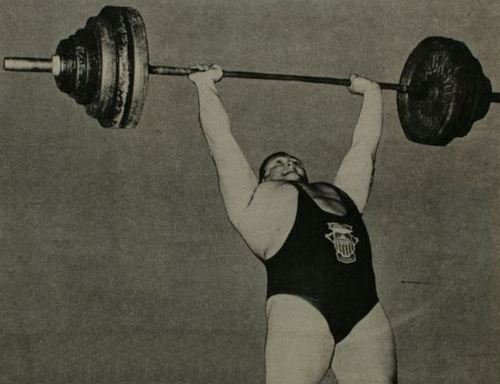
One of Hepburns's secret weapons for building his mighty pressing strength was the practice of the One Arm Military Press, an enormously powerful, but little known exercise. Hepburn considered this movement to have no equal for building overall upper body strength. And, along with the bench press, Hepburn gave the One Arm Press credit for substantially increasing his pressing ability. In the May, 1952 issue of Muscle Power, Hepburn related, “Of one thing that may be certain. Use of the One Arm Military Press will substantially increase your regular two arm pressing.”
Hepburn was inspired to implement the One Arm Press into his training program after he read that Bert Assirati, the British strongman and wrestler, used this exercise to build his extraordinary upper body strength. The Canadian was also influenced by John Davis and by Marvin Wells. Both men were advocates of the One Arm Military Press, and both were among the strongest barbell pressers in the world. Davis could press 150 pounds with his right hand, and he could do reps with 135 pounds. Wells was known to “seesaw” two 120-pound dumbbells for four or five sets of nine reps. To put these accomplishments into perspective, Hepburn noted in 1952, “There are hardly more than eight or nine men on the whole American continent who can perform a correct One Arm Military Press, with either hand, of 130 pounds.”
The One Arm Press, according to Hepburn, builds overall body strength and power like no other exercise can because “it demands that there be no weak link in the physical chain.” This exercise not only greatly stimulates the deltoids and triceps, it superbly strengthens the entire torso and back. Hepburn also observed that the One Arm Military Press “can develop strength of the trunk that can hardly be attained by any other means.” This is because this lift requires a tremendous effort to maintain an upright stance during its execution.
Photo 2
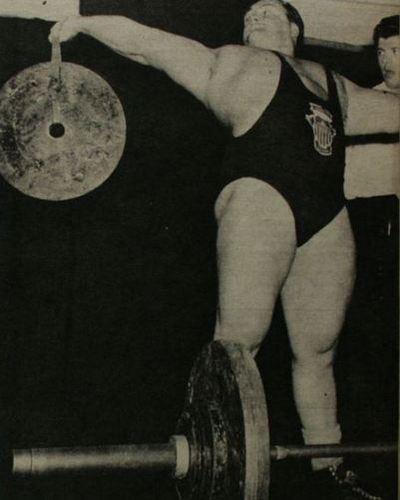
Before we look at how Hepburn trained with the One Arm Press (technically called the Left and Right Hand Military Press) for building sensational body power, let's first take a look at how this movement is correctly performed. The following “official” definition is taken from the 1960 edition of Bob Hoffman's book, Weightlifting:
Left (Right) Hand Military Press
“The dumbell shall be taken to the shoulder and, after a pause of two seconds, pressed to arm's length overhead. At the commencement of the press the bar shall not be held higher than the top of the sternum where the collar bones meet. During the press from the shoulder the trunk must not be inclined backwards, forwards, or sideways: the shoulders must be kept quite level, the legs straight, the heels together, the head held erect with the eyes looking directly to the front, the slightest deviation from the erect position being counted cause for disqualification. In taking the bell to the shoulder either one or two hands may be used. In the performance of this lift the use of a bar bell or ring weight is not permitted.”
The definition given above for the One Arm Military Press was written as a set of rules for sanctioned competition. However, during his training sessions Hepburn sometimes used a “feet apart” style in order to increase body stability. Nonetheless, Hepburn advised that for power building the feet should be moved gradually together. Working the One Arm Press with the feet held together, the Canadian strongman observed, results in greater torso involvement and enhanced power development.
Prior to beginning the One Arm Press, Hepburn rubbed both hands with chalk, and he rubbed chalk between his fingers. The use of chalk helps to ensure that the dumbbell does not slip in the lifting hand. A slight slip, Hepburn warned, can throw the dumbbell out of balance and make the lift awkward and more difficult.
Photo 3

Hepburn also preferred to clean the dumbbell with both of his hands to conserve lifting energy. Just prior to the clean, the strongman would wrap his lifting hand around the bell shaft, and then he would wrap his other hand around his lifting hand. The muscular giant would then swing the dumbbell up high and into the lifting position. Once in the lifting position, Hepburn would keep his shoulders and torso muscles well tensed to maintain a proper stance and to prepare his body for a sudden thrust of power.
To aid his balance, Hepburn would press the dumbbell while keeping his free hand held to his side. As he pressed the dumbbell, he would also keep his muscles tense, especially contracting the muscles of the buttocks and thighs with great force. Doing so helped the mighty presser to maintain a firm position and to generate the explosive power he required to complete the lift.
Photo 4
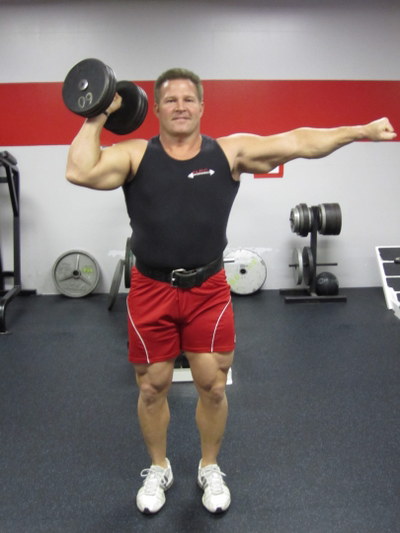
Hepburn preferred to train the One Arm Press only once or twice a week whenever he incorporated this exercise into his training program. After much experimentation, he found that this training frequency provided him with optimum results. For each workout, the big man would begin the One Arm Press by warming up thoroughly with a relatively light poundage. He would then use a weight about 30 pounds below his best lift and perform six to eight sets, each consisting of three repetitions. John Davis, an American heavyweight weightlifting champion between 1938 and 1953, practiced a similar routine. He would perform six to eight sets of the One Arm Press, two repetitions each set.
Hepburn understood that to continually stimulate an increase in strength and power, the lifter must constantly strive to increase their training poundages. As such, Hepburn strove to increase his training weight whenever possible. Using this method, the Canadian strongman was eventually able to press with one arm a 195-pound dumbbell.
Photo 5
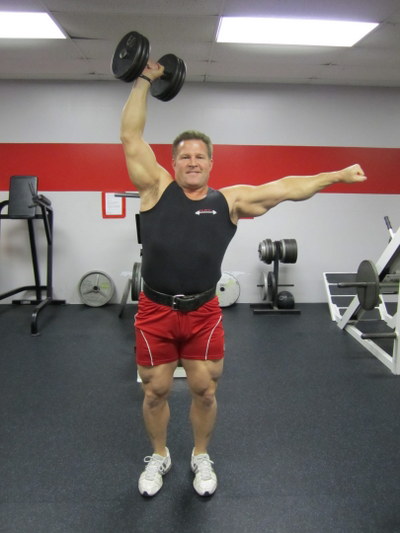
During ordinary training with the One Arm Press, Hepburn would breathe normally, without conscious effort or special technique. However, whenever he attempted a record lift, either in the gym or during a competition, the modern Hercules would utilize a special style of breathing to ensure that he didn't become lightheaded due to lack of oxygen, a potentially dangerous condition that even experienced weightlifters sometimes face during an “all-out” attempt. Hepburn's breathing technique involves five steps: (1) take a slight breath during the clean portion of the lift; (2) breathe out at the completion of the clean, and then quickly begin breathing in; (3) continue to breathe in as the dumbbell is lifted; (4) breathe out as the dumbbell reaches ear level; and (5) breathe in as the dumbbell reaches arms-length, and continue to do so until the referee gives the signal to lower the weight.
Hepburn advised that trainees not make attempts at limit poundages more than once every three or four weeks. Doing so more often, he warned, could cause some lifters to go stale. He also advised that as a training exercise it is not necessary to perform the One Arm Press according to the strict definition given above. Some individuals may gain fastest with a somewhat looser style, he indicated. In fact, the former world champion stated, “A man should work for power first, and then for style and technique perfection.” Following such a formula, Hepburn advocated, leads to faster gains in muscular size, strength, and power.
To add variety to your training routine and to prevent staleness, Hepburn recommended occasionally practicing the One Arm Press while seated on a bench, or with your back held against a wall or pillar. He also suggested that the lift could be practiced while resting the non-lifting side of the body against a wall, with the non-lifting arm held straight down. Hepburn also occasionally practiced the One Arm Press with his non-lifting hand pressed firmly against his body to aid his balance, rather than held straight out.
Photo 6
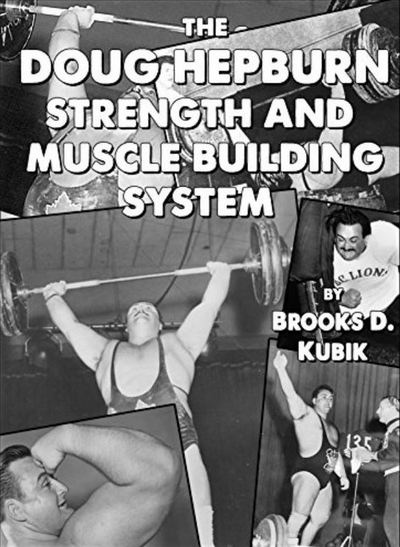
Although at various times Hepburn held world records in the two hands press, the squat, and the bench press, the One Arm Press was his favorite lift. No other lift, Hepburn advised, builds greater pressing power. And, as the former record holder often pointed out, the ability to press a heavy weight overhead is the mark of a true strongman. Think about men like Arthur Saxon, Karl Swoboda, John Davis, Steve Stanko, and Grigory Novak; they were all among the world's strongest men, and they were all pressing sensations.
Epilogue
Doug Hepburn typically trained three or four days per week, and he generally restricted his lifts to two or three per workout. The first lift of his workout was usually one he was striving to improve, and the second was a basic power movement, either the squat or the deadlift. On occasional workout days, when he was feeling particularly energetic, he would also practice a third movement, typically either the bench press or the curl. Throughout his lifting career, Hepburn would specialize on only one or two movements at a time. He would change his training program whenever his progress slowed down, or whenever he felt that he obtained all he could from specialization of a particular lift.
Hepburn most often trained with low repetitions and used poundages around 85% to 90% of his limit lift. Doing eight sets per exercise for two or three reps was common for the big fellow. However, sometimes he trained with reduced poundages, and he performed a higher number of reps and a lower number of sets.
Happy pressing, and may the spiritual force of Doug Hepburn be with you in your quest for greater strength, muscle, and power.
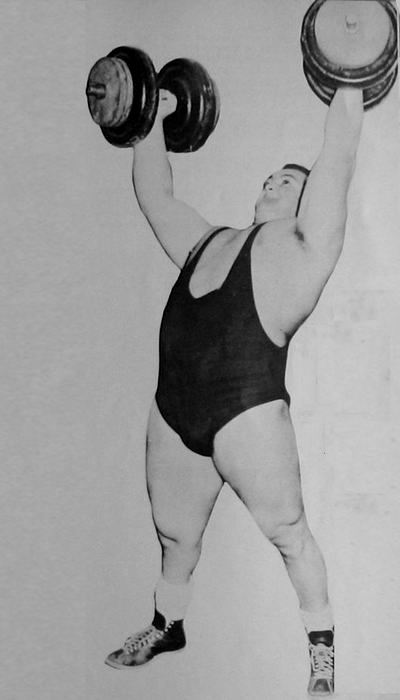
Add Comment